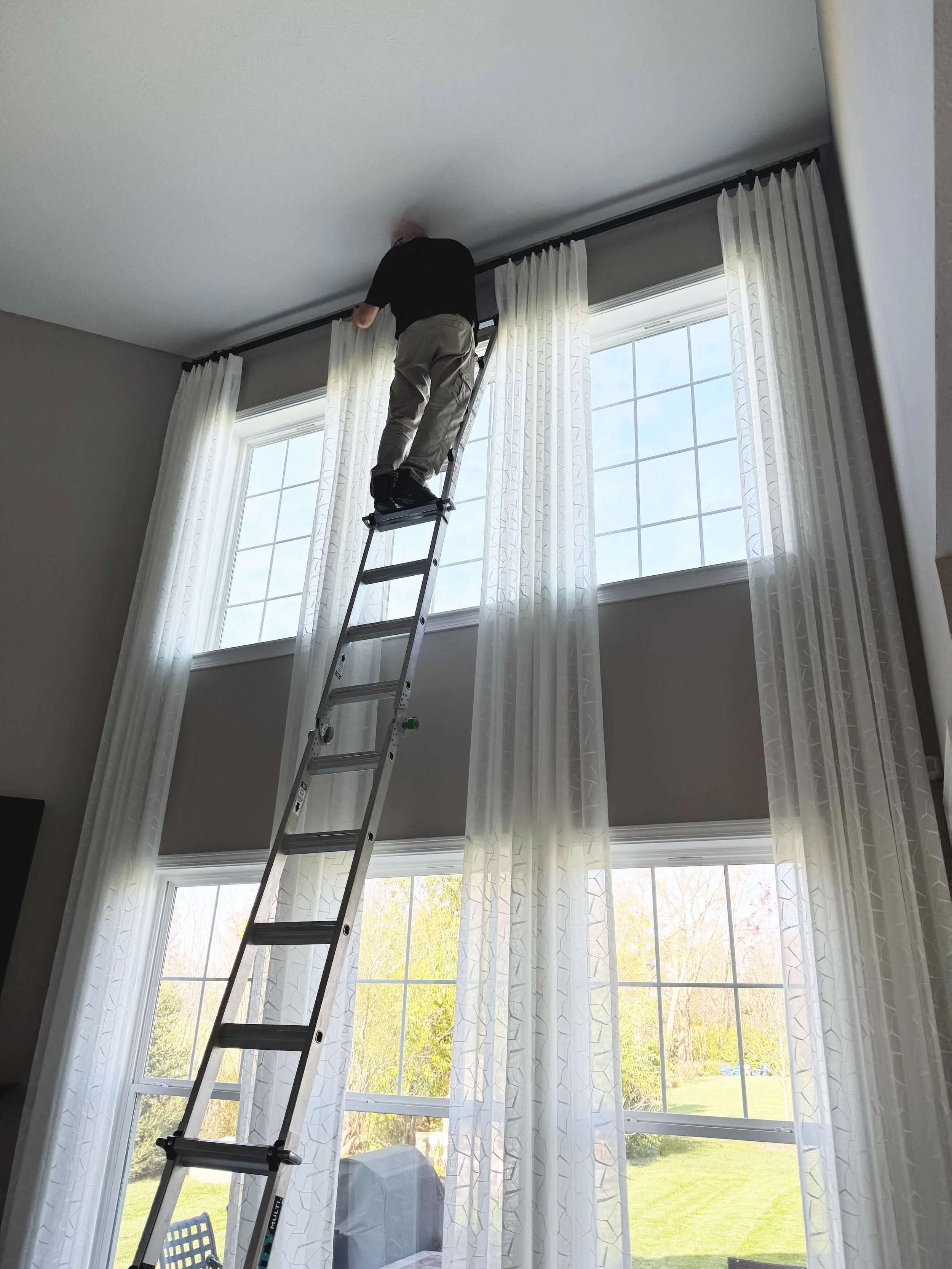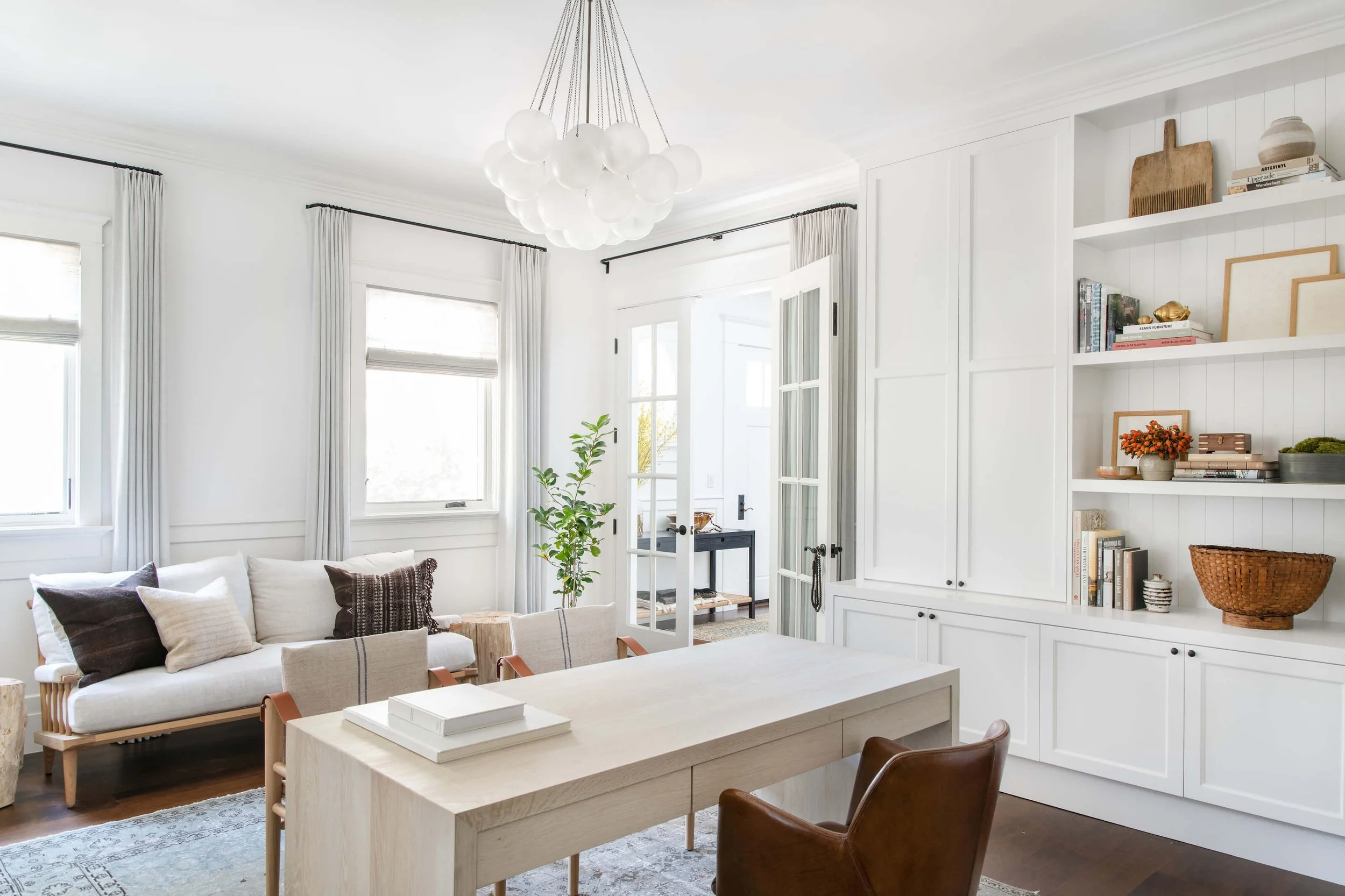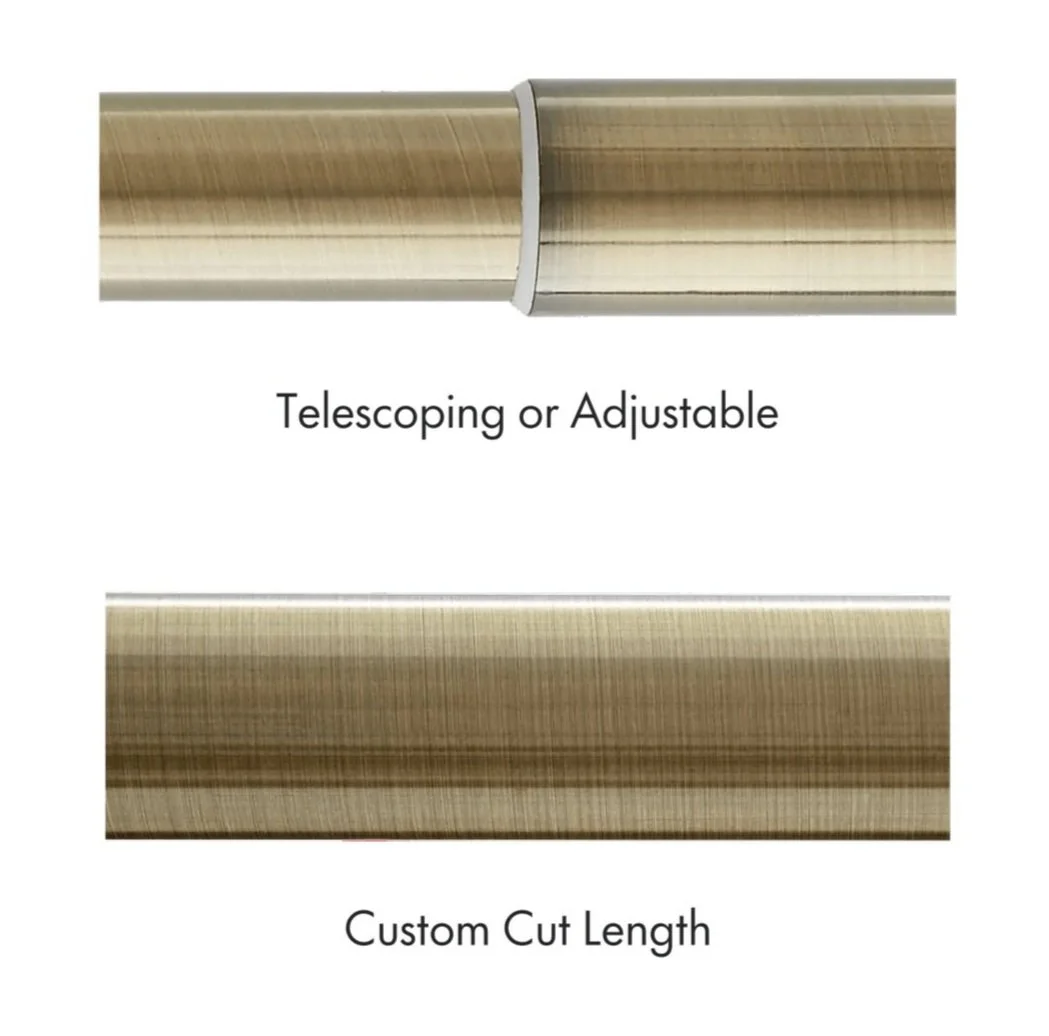Enhance Your Home with Our Detailed Guide to Drapery Hardware Options
Table of Contents Show
We all know how a room just comes together once window treatments are hung. But let’s be honest—most people get completely lost in fabric selection! Who can blame them? With so many stunning prints, patterns, and colors, it’s easy to forget that drapery hardware plays an equal (if not more) important role in the overall look and functionality of your window treatments.
Let’s break down why drapery hardware deserves as much thought as fabric selection!
Performance Comes First
When selecting drapery hardware, prioritize performance. Choose high-quality components that effectively support your drapes' weight and ensure smooth operation. Secure installation is necessary to maximize safety and functionality, especially in homes with children or pets. Prioritizing your hardware’s performance guarantees your draperies remain attractive and easy to operate while remaining hazard-free, even in active households.
Navigating Your Options - Decorative vs. Functional Hardware for Drapery Project
There are two overarching types of drapery hardware: functional and decorative. Decorative drapery hardware enhances the aesthetic appeal of window treatments, adding style and character to a room’s overall design. Functional drapery hardware primarily facilitates the smooth operation of curtains and drapes, allowing them to be easily opened and closed. However, it can also contribute to a room’s decor by complementing the overall design theme and adding a polished finishing touch.
Decorative Hardware
Even if your drapes are purely decorative, hardware still matters. In fact, decorative hardware can be a design focal point, framing your windows and making the room feel finished.
Image courtesy of Highland Forge
Choose decorative hardware if:
You want to highlight the drapery style.
The hardware will be visible and contribute to your design scheme.
You’re aiming for a formal or elegant feel.
You want continuity across your decor.
Drapery Hardware by Vesta Drapery Hardware (From left to right: rod, bracket, finial, ring, holdback, and wands)
Components of decorative hardware:
Drapery Rods: Choose a classic straight rod or a French return rod that curves back to the wall for a seamless finish. They come in wood, metal, resin, and even lucite! Plus, you can add texture with fluted or reeded finishes for extra flair.
Brackets: Brackets hold everything in place! The longer or heavier your rod, the more brackets you’ll need. For a more expansive look, try placing your brackets higher on the wall for an elongated effect.
Finials: Finials are decorative end pieces that fit into the ends of your rod to give it a finished, ornamental look. Go classic with balls and discs, or choose something bold, like a geometric shape.
Rings: Rings encircle the rod and attach to the drapes, making it easy to open and close them. A drapery hook is pinned to the back top of your drapery panels and threaded through a small eyelet on the bottom of the ring. Your drapes hang from the ring, but you only see the ring itself, not how it is attached, for a polished look.
Tiebacks & Holdbacks: Tiebacks are fabric bands gently holding your drapes to the side. Holdbacks, however, are U-shaped metal hooks or mounted to the wall, making it easy to lift the drape out for quick closure. Both add an elegant touch to your drapery setup!
Wands: Drapery wands make opening and closing your drapes effortless. Using a wand also eliminates the need to tug on your drapes, which can lead to soiled and misshapen fabric over time.
Functional Hardware
Functional hardware is the way to go for drapes you’ll open and close regularly. Modern systems even allow you to motorize your setup for a hands-off experience.
Image courtesy of Aria by Rowley Company
Consider functional hardware if:
You’ll be opening and closing your drapes frequently.
You’re covering a large opening, like sliding doors.
Your drapes are heavier and need extra support.
You want a clean, streamlined look.
Image courtesy of Select Drapery Hardware
Components of functional hardware:
Rod or Track: Functional drapes can be hung on either a rod (with rings) or a track (with a carrier system). Tracks are ideal for heavy drapes or drapes covering big openings because they are easy to operate. Today, many manufacturers offer attractive tracks that provide both function and a decorative element.
Brackets: Brackets support drapery rods and tracks, ensuring proper drapery hanging and smooth operation. Brackets for drapery rods come in various styles and sizes that usually match other rod components. Brackets for tracks often have a more discreet design to blend with the wall or track. Track brackets play a critical role in firmly holding the track to provide a smooth surface for traversing drapes.
Carriers: Drapery track carriers, also called glides, sliders, slides, or rollers, are essential components that facilitate the movement of curtains along a curtain track. These carriers can be attached to curtains using various methods, such as hooks or snaps, enabling smooth and effortless operation.
End Caps: Unlike decorative finials, functional tracks often have simple end caps for a sleek, minimalist finish. Some manufacturers offer decorative finials for a more formal aesthetic.
Wands: Wands make drawing heavier or taller drapes open or closed easier. They can match your other hardware components or be made of clear acrylic. Either way, the wands are hung behind the leading edge of the drapery and hidden from sight. We recommend using wands for drapery tracks if draperies aren’t motorized.
Motorization: With motorized tracks, you can open and close your drapes with a remote, wall switch, or app—perfect for convenience and energy efficiency.
Additional Hardware Considerations
Choosing the proper drapery hardware can make all the difference in the functionality and look of your window treatments. Here are some key factors to consider to help you select hardware that works well and enhances your space:
Custom vs. Ready-Made
Custom drapery rods are distinct from non-custom rods in several key ways.
Custom rods are tailored to fit specific window measurements, ensuring a precise fit and optimal functionality. In contrast, non-custom rods are often mass-produced and may not accommodate unique window dimensions.
Custom rods offer greater flexibility in materials, finishes, and styles, allowing you to select from a broader range of options to match your décor.
Custom rods, such as motorized systems, can accommodate specific window treatments. This level of customization enhances both form and function.
Custom-made rods tend to be higher quality, tailored to the exact length you need, and often sturdier than hollow, telescoping, ready-made rods, which aren’t ideal for functional drapes.
Choose custom rods if you need a specific length, have an intricate setup, want a custom finish, value quality, etc.
Choose ready-made rods if you have a standard window size, want a simple look, need a temporary solution, prefer to invest more in the panels, etc.
Single vs. Double Rods
A single rod is perfect for a clean look with one layer, while a double rod is excellent for layering heavier drapes with sheers.
←Hardware by Rejuvenation
Choose a single rod for one layer of drapes, a casual look, or to highlight the hardware. Single rods are perfect for stationary drapery panels that add a decorative accent to your room.
Choose double rods if you need both privacy and light control, have a large window, or plan to layer drapes over sheers.
Rod Size
Rod diameter ranges from 1/2" to 3", with thicker rods supporting heavier fabrics and larger windows.
1/2 – 3/4" rods: Ideal for lightweight fabrics and smaller windows.
1 – 1 3/8" rods: Great for medium-weight fabrics like cotton or linen on standard windows.
1 1/2" or greater: Best for heavy fabrics, tall or wide windows, or more formal settings.
←Hardware by Xentric
Choose a larger rod diameter for heavy drapes, particularly those made from thick fabrics like velvet or lined curtains. A thicker rod can better support the weight and prevent sagging, which is especially important for wide windows or when using very long curtains.
Choose a narrow rod diameter for a sleeker, more streamlined appearance - ideal for smaller rooms or those with limited window space. Additionally, a narrower rod can draw less attention to itself, allowing the focus to be on the curtains or drapes instead.
Materials
Drapery rods come in wood, metal, and lucite, each bringing its unique look and benefits:
Metal: Metal rods offer durability and sleek design options. They’re perfect for heavier drapes or a minimalist look.
Wood: Wood rods pair well with wood furniture, adding warmth for a classic or natural look. Choose wood if your space leans traditional or transitional.
Lucite: This clear, modern material brings any room a light, chic touch. Lucite pairs well with metal accents, though remember that it scratches easily and is best for stationary panels.
← Hardware by Byron & Byron
It’s easy to get swept up in fabric selection, but drapery hardware is the finishing touch that brings it all together. Whether you opt for decorative or functional hardware, taking time with these details will elevate the style and practicality of your window treatments.
Looking for some more help? Book a complimentary Welcome Call with one of our specialists to find the best hardware for your dream drapes!
About the Author
WINDOW TREATMENT SPECIALIST • SOFT FURNISHINGS DESIGNER • EXPERT FABRICATOR • CERTIFIED HUNTER DOUGLAS CONSULTANT
Dana is the owner and principal of The Pinched Pleat. With a lifetime of fabrication and decorating experience, Dana is the creative force behind the company’s bespoke window treatments. Her impeccable eye for detail and quality has made her a go-to expert for custom window treatments, regularly serving renowned interior designers and homeowners nationwide.
-
Dana's articles aim to empower readers to create beautiful soft furnishings that reflect their unique style. She shares her expertise, making stunning window treatments accessible and fun to design. Dana invites you to embark on her creative journey of transforming your spaces - one window at a time.















Both roller and Roman shades can transform your home’s look and feel. Roller shades offer sleek minimalism, easy maintenance, and precise light control, ideal for modern spaces. Roman shades bring elegance with soft folds, superior insulation, and diverse fabric options, perfect for adding sophistication to any room. While roller shades are generally more budget-friendly and low-maintenance, Roman shades provide a luxurious focal point despite higher costs and care needs. Your choice ultimately depends on your style, budget, and practical requirements, with both options capable of dramatically enhancing your living spaces.